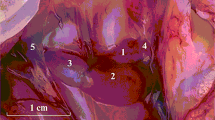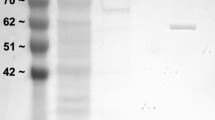Abstract
The properties of glucose-6-phosphate dehydrogenase and 6-phosphogluconate dehydrogenase from gill tissue of the tanner crab Chionocetes bairdi, and lactate dehydrogenase (LDH) and glyceraldehyde dehydrogenase from skeletal muscle of C. bairdi and the yellowfin sole Limanda aspera were examined over the physiological temperature range of the animals. Both animals were obtained in the Bering Sea in winter, and their enzymes appear to be remarkably cold-adapted. Affinity of sole LDH for substrate appears to increase with decreasing temperature, thus keeping reaction rate essentially independent of temperature at physiological concentrations of the substrate. Calculated values of activation energy are low, in keeping with the argument that organisms from cold environments have enzymes with a reduced energy of activation. In addition, Hill plots of the substrate saturation curves for lactate dehydrogenase from muscle of sole indicate that there is a facilitation of allosteric behaviour at low temperatures. Maximum affinity of sole LDH for substrate in the absence of univalent cations occurs at 3°C, while in the presence of 150 mN K+, it occurs between 0° to-2°C. The effects of Mg2+ on enzyme activity appear to be determined by concentration of substrate and temperature. Thus, glucose-6-phosphate dehydrogenase and 6-phosphogluconate dehydrogenase are stimulated more effectively by Mg2+ at low temperature and at low substrate levels whereas, at high concentrations of substrate, they are relatively independent of the bivalent cation. All four dehydrogenases are affected by the univalent cations Na+, K+ and NH4 + in a manner which appears to be determined, in part at least, by concentration of substrate and by temperature. These findings suggest mechanisms for the maintenance and regulation of enzyme activity in poikilothermic tissues at low and changing temperatures.
Similar content being viewed by others
Literature cited
Baldwin, J. and P. W. Hochachka: Functional significance of isozymes in thermal acclimation. Acetylcholinesterase from trout brain. Biochem. J. 116, 883–889 (1970).
Behrisch, H. W.: Temperature and the regulation of enzyme activity in poikilotherms. Fructose diphosphatase from migrating salmon. Biochem. J. 115, 687–696 (1969).
—: Temperature and the regulation of enzyme activity in poikilotherms. Regulatory properties of fructose diphosphatase from muscle of the Alaskan king crab. Biochem. J. 121, 399–409 (1971).
— and P. W. Hochachka: Temperature and the regulation of enzyme activity in poikilotherms. Properties of rainbow trout fructose diphosphatase. Biochem. J. 111, 287–295 (1969).
Bygrave, F. L.: Studies on the interaction of metal ions with pyruvate kinase from Ehrlich ascites tumour cells and from rabbit muscle. Biochem. J. 101, 488–494 (1966).
—: The ionic environment and metabolic control. Nature. Lond. 214, 667–671 (1967).
Dixon, M. and E. D. Webb: The enzymes, 2nd ed. 950 pp. London: Longmans, Green & Co. Ltd. 1964.
Flemister, S. C.: Histophysiology of gill and kidney of the crab Otypode albicans. Biol. Bull. mar. biol. Lab., Woods Hole 114, 37–48 (1959).
Gelb, W., E. Oliver, J. F. Brandts and J. H. Nordin: An unusual kinetic transition in honeybee glyceraldehydephosphate dehydrogenase. Biochemistry N.Y. 9, 3228–3235 (1970).
Helmreich, E. and C. F. Cori: The effects of pH and temperature on the kinetics of the phosphorylase reaction. Proc. natn. Acad. Sci. U.S.A. 52, 647–654 (1964).
Hickman, C. P., R. A. McNabb, J. S. Nelson, E. D. Van Breemen and D. Comfort: Effect of cold acclimation on electrolyte distribution in rainbow trout (Salmo gairdneri). Can. J. Zool. 42, 577–597 (1964).
Hochachka, P. W. and G. N. Somero: The adaptation of enzymes to temperature. Comp. Biochem. Physiol. 27, 659–668 (1968).
— and G. N. Somero: Adaptations to the Environment. In: Fish physiology, Ed. by W. S. Hoar and D. J. Randall. New York: Academic Press 1971. (In press).
Hubert, E., J. Villanueva, A. Gonzalez and F. Marcus: Univalent cation activation of fructose 1,6-diphosphatase. Archs Biochem. Biophys. 138, 590–597 (1970).
Iwatsuki, N. and K. Okazaki: Mechanisms of regulation of deoxythymidine kinase of Escherichia coli. II. Effect of temperature on the enzyme activity and kinetics. J. molec. Biol. 29, 155–165 (1967).
Johnson, P. R. and C. W. Hartman: Environmental atlas of Alaska, 111 pp. College, Alaska: University of Alaska Press 1969.
Moon, T. W.: Isozymes in temperature acclimation: tront NADP-linked isocitrate dehydrogenase. Fedn Proc. Fedn Am. Socs exp. Biol. 29, 400a (1970).
Newell, R. C.: Effect of temperature on the metabolism of poikilotherms. Nature, Lond. 212, 426–428 (1966).
—: Oxidative activity of poikilotherm mitochondria as a function of temperature. J. Zool., Lond. 151, 299–311 (1967).
— and H. R. Northcroft: A re-interpretation of the effect of temperature on the metabolism of certain marine invertebrates. J. Zool., Lond. 151, 277–298 (1967).
Nordin, J. H., R. Duffield, N. Freedman, W. Gelb and J. F. Brandts: Enzyme activity in cryobiological systems. Cryobiology 6, 373–384 (1970).
Prosser, C. L.: The nature of physiological adaptation. In: Physiological adaptation, pp 1–185. Ed. by C. L. Prosser. New York: Ronald Press Co. 1957.
Rahn, H.: Gas transport from the external environment of the cell. In: Development of the lung, pp 1–408. Ed. by A. V. S. DeReuck and R. Porter, London: J. & A. Churchill Ltd 1965.
Rao, K. P.: Physiology of acclimation to low temperature in poikilotherms. Science, N.Y. 137, 682–683 (1962).
Read, K.: The temperature coefficients of ribonucleases from two species of gastropod molluses from different thermal environments. Biol. Bull. mar. biol. Lab., Woods Hole 127, 489–498 (1964).
Reeves, R. B. and T. L. Wilson: Intracellular pH in bullfrog striated and cardiac muscle as a function of body temperature. Fedn. Proc. Fedn Am. Socs exp. Biol. 28, 728a (1969).
Robin, E. D.: Relationship between temperature, plasma pH and carbon dioxide in the turtle. Nature, Lond. 195, 249–251 (1962).
Sanwal, B. D.: Regulatory mechanisms involving nicotinamide adenine nucleotides as allosteric effectors. III. Control of glucose-6-phosphate dehydrogenase. J. biol. Chem. 245, 1626–1639 (1970).
Scholander, P. F., W. Flagg, V. Walters and L. Irving: Climatic adaptation in arctic and tropical poikilotherms. Physiol. Zoöl. 26, 67–92 (1953).
Somero, G. N.: Pyruvate kinase variants of the Alaskan king crab. Evidence for a temperature-dependent interconversion between two forms having distinct kinetic and adaptive properties. Biochem. J. 114, 237–241 (1969).
— and P. W. Hochachka: The effect of temperature on catalytic and regulatory functions of pyruvate kinase of the rainbow trout and the Antarctic fish Trematomus bernachii. Biochem. J. 110, 395–400 (1968).
Taketa, K. and B. Pogell: Allosteric inhibition of rat liver fructose 1,6-diphosphatase by adenosine 5′monophosphate. J. biol. Chem. 240, 651–662 (1965).
Toews, D. and C. P. Hickman: The effect of cycling temperatures on electrolyte balance in skeletal muscle and plasma of rainbow trout Salmo gairdneri. Comp. Biochem. Physiol. 29, 905–918 (1969).
Umminger, B.: Physiological studies on supercooled killifish (Fundulus heteroclitus). I. Serum inorganic constituents in relation to osmotic and ionic regulation at subzero temperatures. J. exp. Zool. 172, 283–302 (1969).
—: Osmoregulation by killifish in fresh water at temperatures near freezing. Nature, Lond. 225, 294–295 (1970).
Vesell, E. S.: pH dependence of lactate dehydrogenase isozyme inhibition by substrate. Nature, Lond. 210, 421–422 (1966).
— and K. L. Yielding: Effects of pH, ionic strength, and metabolic intermediates on the rates of heat inactivation of lactate dehydrogenase isozymes. Proc. natn. Acad. Sci. U.S.A. 56, 1317–1324 (1966).
Vroman, H. E. and J. R. C. Brown: The effect of temperature on the activity of succinie dehydrogenase from lives of rats and frogs. J. cell. comp. Physiol. 61, 129–131 (1963).
Author information
Authors and Affiliations
Additional information
Communicated by J. Bunt, Miami
Rights and permissions
About this article
Cite this article
Behrisch, H.W. Molecular mechanisms of adaptation to low temperature in marine poikilotherms. Some regulatory properties of dehydrogenases from two arctic species. Marine Biology 13, 267–275 (1972). https://doi.org/10.1007/BF00348073
Accepted:
Issue Date:
DOI: https://doi.org/10.1007/BF00348073




